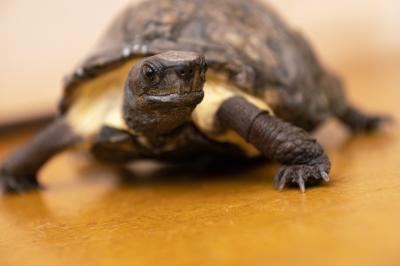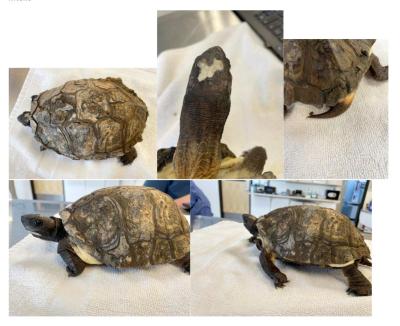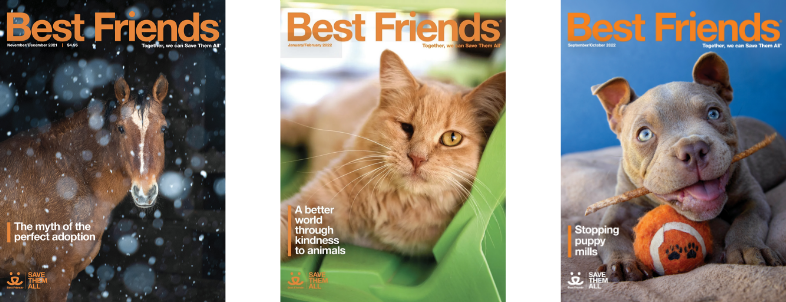Rehabilitating a mystery turtle

Our world is full of mysteries, myths, and legends — sightings and phenomena unexplained and unconfirmed by science that, nevertheless, gain a foothold in our collective imaginations and stick around. When that mystery is an animal often claimed to exist but never proven to, it’s called a cryptid; think Bigfoot, the chupacabra, or the Loch Ness monster.
Well, recently, Best Friends Animal Sanctuary welcomed our own little mystery. And while Cryptid definitely exists, there is a whole lot about the curious turtle that remains unknown. What we do know is this: She was found far away from anywhere she belonged, and she needed help.

A turtle out of water
This Cryptid’s story began when she somehow wound up wandering the desert sands all on her own. She is, unequivocally, a species of turtle, and turtles live in water — though even had she found a creek or pond, she still was not native to the area. She was very, very out of place, and somewhere along the way she had been hurt. Her shell was broken.
Then, in the way mysterious creatures sometimes are, she was spotted on the side of the road. A kind-hearted person pulled over to check on her, saw her injury, and decided to help. He brought her home and tried to take care of her and give her what she needed to heal, but there was a case of mistaken identity. Given where Cryptid was found, it’s not unreasonable that her discoverer thought she was a desert tortoise. When she needed water to swim in and bugs to eat, she was given a dry tank and meals of fruits and veggies.
[Secrets of a desert tortoise]
With time, Cryptid’s shell did begin to heal, but her overall condition was not improving. The person who found her began looking for help — and when he met a woman with pet tortoises and knowledge about reptiles, he asked for her assistance. She saw right away that his mystery creature wasn’t a desert dweller at all; Cryptid was a turtle and in need of expert intervention.
So she reached out to Wild Friends, Best Friends’ state and federally licensed wildlife rehabilitation and education center. There, Cryptid’s long road to recovery could really begin.

Scrubs and special care for a turtle
When Cryptid arrived at the Sanctuary and was checked out by veterinarians and the rehab team, her old injury was of least concern. Her whole shell was gray and uneven, with shell rot, poor nutrition, and scarring changing it from the healthy black it should have been. She was also overweight, yellow skin bulging out around where her head and limbs emerge from her shell. And, worst of all, she was missing some skin on her head and face.
She was in such a state that her species was completely unidentifiable. She wasn’t a snapping turtle or variety of soft shell or painted turtle native to Utah. In fact, she didn’t look like any species common in the United States.
“We’ve talked to several experts in Utah and Arizona,” says Lauren Ross, Wild Friends caregiver and licensed rehabilitation sub-permittee. “(And I’ve even) posted around reptile forums — people have gotten in fights about it.” The answer that came up the most was that Cryptid may be an Asian leaf turtle, but even the experts weren’t completely sure.
[5 remarkable reptiles at Best Friends Animal Sanctuary]
Thus, the effort to bring Cryptid back into top shape began in earnest. Turtle shells, just like a human’s hair and nails or a horse’s hooves, are made of keratin and constantly growing. If they are injured, they can grow back good as new with the right care. So it was not a particularly difficult or tricky treatment that Cryptid needed, but it would take time and patience. Each morning, caregivers apply an antibacterial cream to her shell and let it soak in over the course of the day. Then, at the end of the day, she gets a pleasant scrub under the faucet to remove what’s left.
“(The scrubs) help regenerate the shell, too, scrubbing in little circles,” Lauren explains. “It’s just time-consuming, and it will just take a while because she’s got to shed all of those layers.”
The rehab team also “dry docks” Cryptid for several hours a day. While a turtle would normally climb onto a basking rock or log to soak up the sun’s warmth and UV rays for a while, Cryptid refuses to get out of the water on her own — perhaps unsurprisingly, given how long she went without it. But that dry time is just as important for her health as having water to swim in.
Happier, healthier reptile
With proper care, Cryptid’s skin has healed back over the once-exposed bone, and she is slowly getting back into shape. She doesn’t have much of an appetite for her healthy new diet; a year of yummy but not-very-nutritious junk food is hard to move on from, it seems.
“She still has a long way to go,” Lauren says, “which is unfortunate because that wound was not terrible, but the treatment that she’s going to have to receive is going to be long-term because she was treated like a tortoise and just had the wrong care.”
Cryptid is in good spirits though. When the rehab team is working nearby, she gets supervised exploration time in the office, and she takes full advantage of it. She enjoys climbing over (and occasionally getting stuck behind) shoes, and she zooms around at top turtle speed to find new things to play with. She’s not shy at all around people, and it’s pretty impossible not to be charmed by her ever-curious personality.
Whether Cryptid can eventually go to a new home or stay at Wild Friends as an educational ambassador has yet to be decided. She needs more time to heal, and her species is still a mystery to be solved. But her future is in good hands now, and whatever it holds she’ll have an important message to share.
For now, Lauren will help her with it: “Don’t try to save wildlife on your own. ... Please bring them in to a rehab center, or to a vet, instead of trying to do it yourself.”
This article was originally published in the May/June 2023 issue of Best Friends magazine. Want more good news? Become a member and get stories like this six times a year.
Get wild at Best Friends
There’s always something exciting happening at Wild Friends, where injured local wildlife receive essential medical care.
Find out more about Wild Friends
Read more
Birds, bunnies and snakes, oh my: 8 wild animal rescue stories
